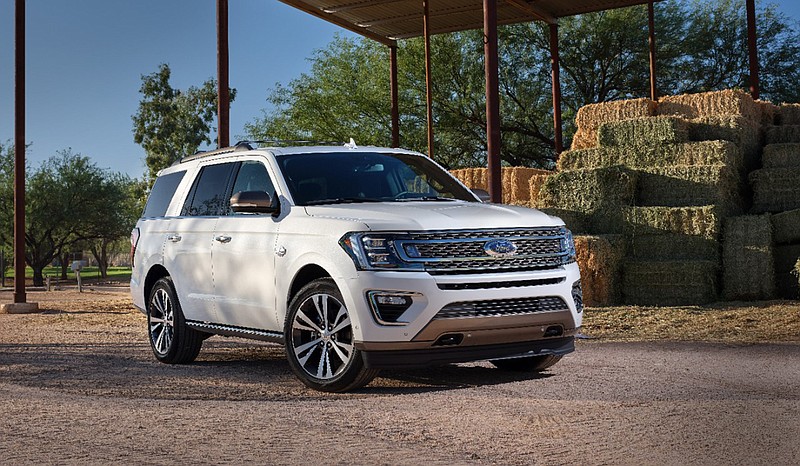As Ford transforms its truck to electric platforms, perhaps no vehicle will benefit more than the Expedition.
Massive, powerful, and competent in manifest ways, the Expedition shares a platform and many mechanicals with America's best-selling vehicle, the F-150, which next spring will be available in all-electric form and at competitive prices.
Like nearly all auto manufacturers - alas, poor Chrysler - Ford is transforming itself into a maker of electric vehicles. CEO Jim Farley recently announced an additional $22 billion in electrification spending through 2025 to build assembly plants, battery factories, and charging stations, and to do research and development of new products.
We can in good faith engage in a spirited debate regarding the desirability of this change but in the end, this is coming about not because of the climate and not because or politics. It is just business.
Less cost, more profit
Electric vehicles have many fewer moving parts and, thus, are not only immensely more reliable (how often have you seen a ceiling fan break?) but also require smaller parts inventories, shorter supply chains, and much less - like waaay less - labor cost to manufacture.
Sequitur (therefore it follows), automakers can sell electric vehicles for the same price as internal-combustion ones and make more money. That has not yet occurred because we are still in the beginning phase of skim theory, which holds that if some folks will pay $100 for something, sell it to them at that price until you run out of people so inclined. Then move on to the people who will pay $90, $80, et cetera (and the others).
This is why phone makers continuously develop new models.
It also has not occurred because we are at the beginning stage of another theory, the diffusion of innovation. This one holds that adoptions of new technologies are at first slow until they reach an inflection point. Then their use explodes exponentially.
Everyone who remembers the time before cell phones, raise your hands.
Multiple factors will drive the adoption of electric vehicles. The main one is that no one knows better how to manipulate our emotions to create desire than automakers. When the spigots of advertising dollars are opened it will make the flow from a fire hose look like a water pistol.
Another is that automakers and utility companies see charging stations as profit centers. Before Congress ever acts on infrastructure - if, is more like it - billions of dollars will be invested on building out the charging network.
At the same time, battery technology is expanding rapidly. I am already hearing whispers of 600-mile ranges.
Yet another is that electric power costs about a third of carbon fuel and is three times more efficient. A gas motor turns about 30 percent of fuel into energy, the rest is lost to heat and pollution. An electric motor uses more than 90 percent of its energy.
Finally, electric vehicles will turn out to be good deals for buyers, with or without tax incentives. They cost less to operate. There's no cooling or exhaust systems to maintain. Brakes regenerate energy instead of wearing out. Here's the first-year maintenance: Rotate tires, change windshield wipers. Because there is little friction inside an electric motor, life expectancies of a half-million miles or more are reasonable. This translates into high resale values.
Change gonna come
Oh, the Luddites will rage. They always do, but alea iacta est. The die is cast.
I lapse into Latin here not only because this is the first time in 50 years I have found a practical return for all the hours spent in study thereof, but also to remind you that, for more than seven centuries, this particular language was held up as the ideal for scholarship, statesmanship, and literary legerdemain (Old French for sleight of hand, but it is from Latin de, of, and main, hand).
Then it died, which means I wasted my youth mastering two dead languages. The other? English. (Full disclosure, I wasted it on other things as well).
We are not yet at the death of the internal combustion engine. Omnia mutantur, nihil interit (everything changes, nothing perishes). According to Statista.Com, about 280 million motor vehicles operate on American roads. In an average year, 40 million change hands. About 14-15 million new vehicles enter the fleet and a similar number retire to junkyards and scrapyards.
According to IHS Markit, in 2020, all-electric vehicle registrations in the U.S. (plug-in hybrids were excluded), reached a record market share of 1.8 %. That is about to expand exponentially. Dozens of electric vehicles - many targeted at the middle class - will hit the market in the next three years.
Still, if every new vehicle sold were electric, it would take 20 years to exchange the American fleet.
All of which means gas stations, mechanics and parts stores will be around for years, (though they will increasingly find themselves competing with dealerships hungry for repair business). Still, in our grandchildren's lifetimes they will be as hard to find as blacksmiths, buggy makers, and hitching posts.
Expedition a dinosaur
This brings us back to the Expedition, which most critics agree is the best full-size SUV on the market. Priced between $49,625 and $79,425, it is marginally better than the similarly priced Toyota Sequoia. Both have abysmal fuel economy - 16 mpg in the Expedition, 15 in the Sequoia.
The Expedition rides and handles better, the Sequoia is more reliable, but both ride on truck ladder frames, so neither is as serene nor composed as their price category would suggest.
GM also makes full-size SUVs, like the Suburban, Tahoe, Yukon, and Escalade, and Nissan offers the Armada. Consumer Reports does not recommend any of these, and neither do I. In the case of the GM vehicles, made in Arlington, Texas, the company has ceased investing in engineering and styling. Here's the tell: advertising that reduces to arguments over who has the better tailgates.
While continuing to build these vehicles - which are at once immensely popular and gobsmackingly profitable - GM has shifted budget and human capital to electrification.
The real problem with these trucky SUVs is that consumers can spend half as much and get twice the fuel economy on crossover (meaning, built on a car-like chassis) seven-seaters like the Kia Telluride, Toyota Highlander, Honda Pilot and Chevy Traverse. These vehicles ride and handle much better and have all the capacity, whether that be hauling a trailer or going off-road, that most families need.
At the same time, automakers are beginning to offer hybrid and plug-in hybrid technology in crossover SUVS, meaning 30-35 mpg is attainable. Even that does not sound that good compared to the Ford F-150 Lightning's EPA-estimated 108 mpg equivalent mileage.
When hundreds of people are dropping dead from heat and Western Canada is burning, getting that kind of fuel economy starts to sound like a 21st century thing to do.



